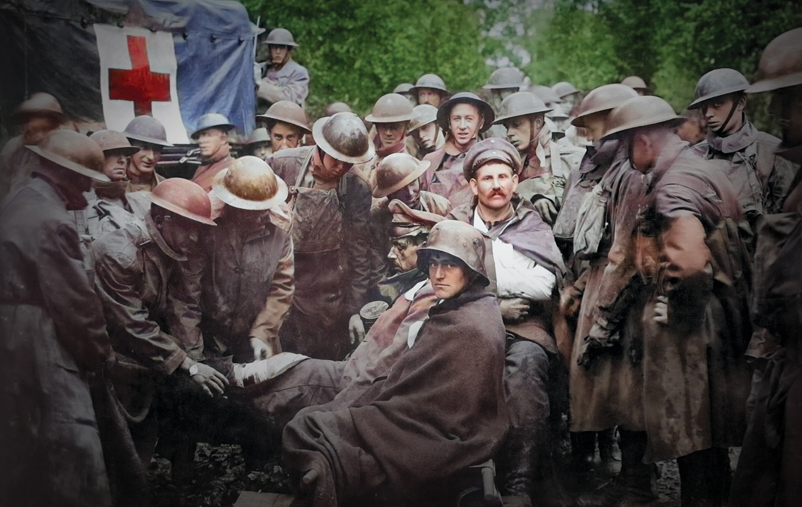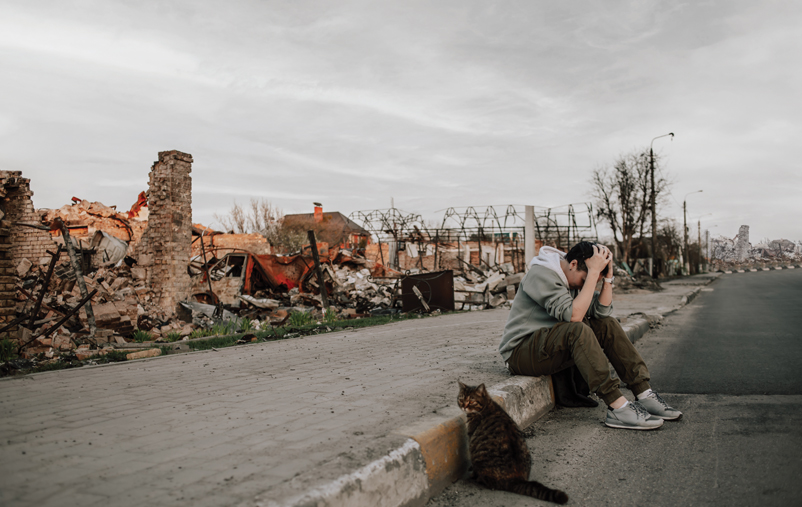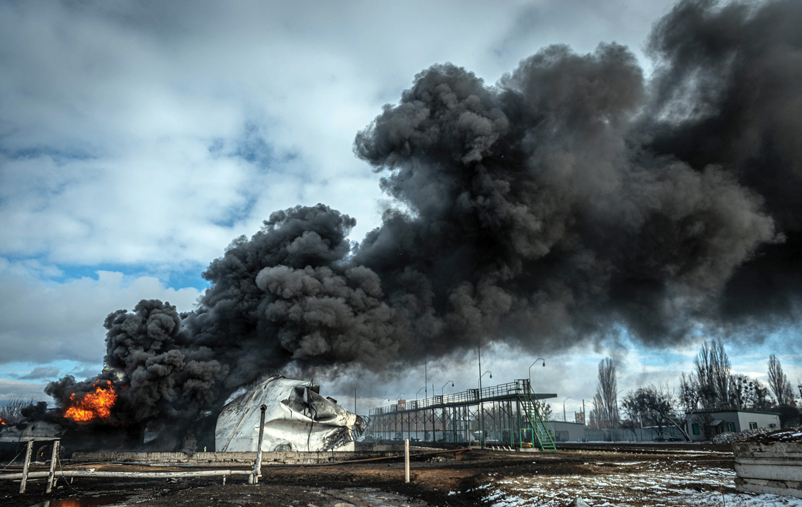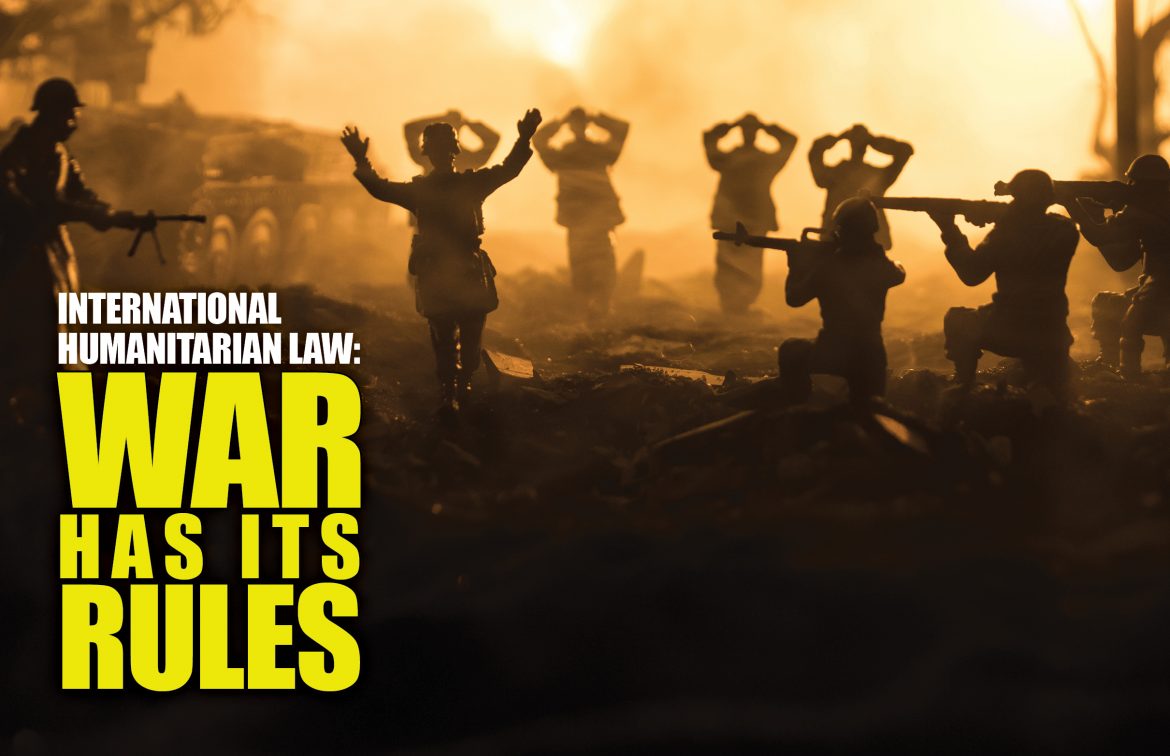War has always been subject to some principles and customs rooted in ancient civilizations and religions, however, humans have always been the first victims of wars and its tragedies, injuries, disabilities, diseases, deaths, forced migrations and damage to the natural environment and infrastructure that directly and indirectly harm civilians. Perhaps the biggest example of this is the catastrophic consequences left by World War II and World War III on civilians and the environment, the effects of which are still present today due to the size and type of destruction that resulted from the use of conventional and non-conventional weapons.

World War I (1914-1918) saw unprecedented atrocities and about 9 million fatalities including a large number of civilians, however, the international community only felt the imminent danger of war on civilians in World War II, which killed 60 million people (more than 5 % of the world’s population at that time).
From then on it became clear that technical and military progress foretells a growth in the number of casualties of war in the future.
The famous German physicist Albert Einstein once said that he does not know what World War III will be like, but he doubts that there will be anyone left alive to see World War IV. This prompted the international community to adopt an international initiative to protect civilians in times of war, taking into account previous treaties and agreements as well as the experience gained from the two world wars, and International Humanitarian Law was one of its most important tools. International Humanitarian Law is a branch of general international law, emerging as an alternative to the term law of war, which gradually changed to the law of armed conflicts and remained for a while before changing again to International Humanitarian Law Despite the change in definitions, this law has always had a clear goal, which is protecting people who suffer from the scourge of war.
What is international humanitarian law?
International humanitarian law is a set of rules intended to limit the effects of armed conflict for humanitarian reasons. The world has agreed on a set of international rules that define what can and cannot be done during an armed conflict.
These rules aim to limit the repercussions of armed conflicts and protect people who do not participate or who cease to participate in hostilities.
Furthermore, this law restricts the means and methods of war, and its ultimate goal is to provide protection to civilians, ensure their survival, preserve some humanity in armed conflicts, save lives, alleviate human suffering, and protect the environment necessary for the existence of human life. However, it is necessary to point out that there is a difference between international humanitarian law, which governs the conduct of parties involved in armed conflicts (the law of war), and general international law enshrined in the Charter of the United Nations, which regulates the legality of a state’s resort to the use of armed force against another state (the law of waging war).
The Charter prohibits resorting to force, but it includes two exceptions: the first is in cases of self-defence against armed attacks, and the second exception is when the United Nations Security Council authorizes the use of armed force.
On the other hand, International humanitarian law does not examine whether or not there are legitimate reasons behind the outbreak of the conflict but rather seeks to regulate the behaviour of the warring parties immediately after the outbreak of war.
The Origins of International Humanitarian Law
The origin of international humanitarian law dates back to the mid-19th century. During the Battle of Silverino (1859) between Napoleon’s third army and the Austrian army, Henry Dunand, a Swiss man, saw the horror of the war and decided to transport the wounded and dead free of charge from the battle fronts and without discrimination to the town.
Based on that war experience, Dunand published a book titled “Memories from Silverino” in 1862, which included a call to alleviate the suffering of soldiers in wars and suggested that countries allow neutral humanitarian organizations to treat soldiers during wars.
The codification of international humanitarian law began in the 19th century, notably with the adoption of the Geneva Convention of 1864 for the Amelioration of the Condition of the Sick and Wounded in Armies in the Field and the St. Petersburg Declaration of 1868 prohibiting the use of certain missiles in the time of war.
Since then, countries have developed a set of practical rules to keep pace with the development of means and methods of war as well as face the humanitarian consequences that result from it.
The rules of international humanitarian law aim to strike a delicate balance between humanitarian considerations and the military requirements of states and non-state parties involved in an armed conflict, dealing with a wide range of issues, including the protection of wounded, sick and shipwrecked members of the armed forces, the treatment of prisoners of war and detainees in connection with armed conflict, the protection of the civilian population, and restrictions on the use of certain weapons and methods of warfare.

Sources of international humanitarian law
The Geneva Conventions and their additional protocols are international treaties that contain the most important rules for limiting the barbarity of war. These conventions provide protection for people who are not taking part in hostilities (civilians, health workers and relief workers) and those who stopped participating in hostilities such as the wounded, sick, shipwrecked and prisoners of war.
The Geneva Conventions and their Additional Protocols are at the core of international humanitarian law which regulates the behaviour of the warring parties during armed conflicts and seek to limit their effects.
The 4 Geneva Conventions, which have received universal ratification, constitute the core principles of international humanitarian law.
These conventions were supplemented in 1977 by Additional Protocol I for the Protection of Victims of Armed Conflicts and Additional Protocol II for the Protection of Victims of Non-International Armed Conflicts.
Other international treaties prohibit the use of certain means and methods of warfare and protect certain categories of people from the effects of hostilities. These treaties include:
• The 1925 Protocol for the Prohibition of the Use in War of Asphyxiating, Poisonous or Other Similar Gases.
• The 1954 Convention for the Protection of Cultural Property in the Event of Armed Conflict and its 1954 and 1999 Protocols.
• The 1972 Convention on the Prohibition of the Development, Production and Stockpiling of Bacteriological (Biological) and Toxin Weapons and on Their Destruction.
• The 1976 Convention prohibits the use of environmental modification techniques for military or any other hostile purposes.
• The 1980 Convention on Prohibitions or Restrictions on the Use of Certain Conventional Weapons Which May Be Deemed to Be Excessively Injurious, and its Five Protocols of 1980 (Protocols I, II and III), 1995 (Protocol IV) and 2003 (Protocol V).
• The 1993 Convention on the Prohibition of the Development, Production, Stockpiling and Use of Chemical Weapons and on Their Destruction.
• The 1997 Convention on the Prohibition of the Use, Stockpiling, Production and Transfer of Anti-Personnel Mines and on Their Destruction.
• The Optional Protocol to the Convention on the Rights of the Child of 2000 on the involvement of children in armed conflict.
• The 2006 International Convention for the Protection of All Persons from Enforced Disappearance.
• The 2008 Convention on Cluster Munitions.
Principles of International Humanitarian Law
1
Balance between military and humanitarian imperatives: International humanitarian law is based on the balance between military and humanitarian necessities. On the one hand, it acknowledges that to defeat an enemy in war, it may be necessary to cause death, injury, and destruction, as well as impose security measures that are more severe than would be permitted in peacetime. On the other hand, it shows that military necessity does not give the warring parties an absolute right to wage war without restrictions and that humanitarian considerations impose certain limits on the means and methods of fighting and an obligation to treat captured enemies humanely.
2
Discrimination: Discrimination between military assets and civilians is a key principle of international humanitarian law, as it is based on the recognition that the only legitimate aim of states during a war is to weaken the enemy’s military forces, while the civilian population enjoys general protection against the dangers arising from military operations.
Consequently, the warring parties must distinguish in all cases between the civilian population, enemy combatants and military targets, then direct their operations against military objectives only.
3
Proportionality: When causing harm to civilians is unavoidable, the decision is then subject to the principle of proportionality. Thus the commanders planning an attack must refrain from it or suspend it if it is expected to cause excessive loss of civilian life, injury, or damage to civilian institutions that are disproportionate to the tangible and direct military advantage it is supposed to provide.
4
Unnecessary Suffering: International humanitarian law not only protects civilians from the effects of hostilities but also prohibits or restricts means and methods of warfare deemed to cause unnecessary suffering or injury between warring parties. In 1868, the St. Petersburg Declaration recognized that the only legitimate aim of states during a war was to weaken the military forces of the enemy.
International Humanitarian Law & Modern Technologies
Technological advances have resulted in new means and methods of warfare, such as cyber-attacks, drones, and armed robots, raising new humanitarian and legal challenges, thus when developing or acquiring a new weapon, means or method of warfare, it is very important for any country to assess the compliance of these weapons and methods with international humanitarian law.
However, the application of pre-existing legal rules to new technologies may raise questions about the adequacy and clarity of these rules, in light of the distinctive characteristics of that technology and the humanitarian impact that can be predicted.
International humanitarian law faces constant challenges as a result of the development of contemporary armed conflicts and the development of its tools and methods. Furthermore, achieving greater protection for civilians in armed conflicts depends on respecting, implementing and enforcing international humanitarian law. Civilians are the main victims of violations of international humanitarian law committed by states and parties to the conflict in contemporary armed conflicts.
The nature of contemporary armed conflicts has always posed challenges regarding the application and respect of international humanitarian law in several areas, ranging from the classification of armed conflicts to the use of modern technologies. Thus it is necessary to understand and respond to these challenges to ensure that international humanitarian law continues to fulfil its protective mandate in situations of armed conflict. A variety of new technologies have entered modern battlefields, as cyberspace made it possible to wage a new type of war, while parties to armed conflicts have increasingly used remotely controlled weapon systems such as drones. Moreover, the use of automatic weapon systems is increasing and specific autonomous systems such as combat robots are being studied for use on future battlefields. Even though international humanitarian law applies to these new weapons and technologies, they present new legal and practical challenges in ensuring that they are used in compliance with existing rules and that due consideration is given to the expected humanitarian consequences of their use.

International Humanitarian Law & The Environment
International humanitarian law aims to protect the civilian population during armed conflicts and ensure their survival. Hence, it seeks to protect the natural environment without which human life is impossible.
International humanitarian law strives to protect the environment in two ways: First is through its general provisions.
Second is through some special additional provisions.
The general provisions regarding the conduct of hostilities apply to the environment, given that the environment is mostly of a civilian nature and therefore attacks cannot be launched against it unless it is turned into a military target.
Furthermore, environmental destruction must be taken into account when assessing the proportionality of an attack on military targets. Protocol I added a specific provision prohibiting “the use of means or methods of warfare which are intended, or may be expected, to cause severe, widespread and long-term damage to the natural environment.” The Protocol also prohibits deterrence attacks against the environment as retaliation.
The 1998 Rome Statute of the International Criminal Court considers all acts that cause widespread, long-term and severe damage to the environment in violation of the principle of proportionality a war crime. Other special provisions prohibit the destruction of agricultural land and drinking water facilities with the intent to harm the civilian population.
Thus, in 1977 the international community adopted a convention on the prohibition of the use of environmental modification techniques for military or any other hostile purposes, which is often referred to as the “environmental change” treaty. The technologies mentioned in the agreement include any method used to effect change “by intentional control of the natural processes, dynamics, composition or structure of the Earth.”
Each state party to this agreement pledges not to use technologies that alter the environment “with widespread, long-term or severe effects, as a means of causing destruction, loss or damage to any other state party”.
« By: Retired Colonel Eng. Khaled Al-Ananzah
(Advisor and Trainer in Environmental and Occupational Safety)













